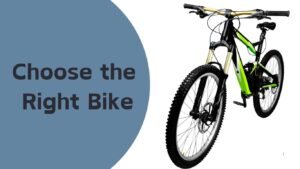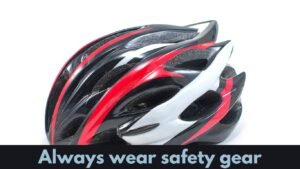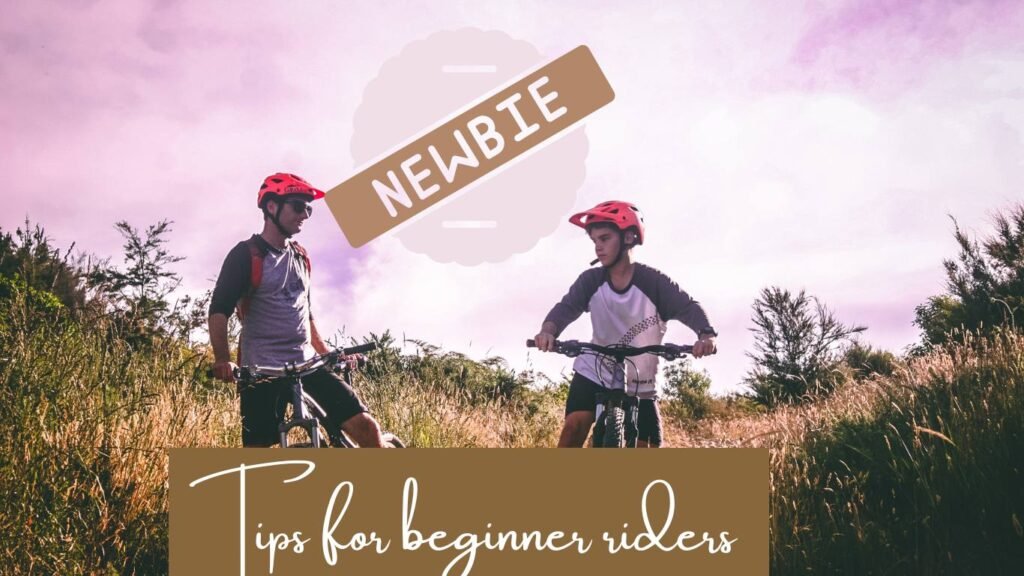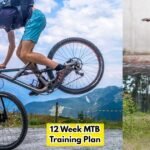Mountain biking is an interesting sport, but many people get intimidated by it, especially beginners because mountain biking often involves many obstacles.
Therefore, beginners get confused while thinking about what skills they need. What should I wear? What essential gear do I need? How can I avoid injury? Too many questions come to mind.
But don’t worry, in this guide, I will share the ten most essential mountain biking tips for beginners.
If you follow them as a beginner, you will be able to ride an MTB confidently and enjoy it fully.
1. Choose the Right Bike for Your Ride

If you are a beginner and just starting your mountain biking journey, first, you need to choose the right mountain bike for you based on your body weight, riding style, safety, comfort, and performance you want.
Things to Consider:
Hardtail bikes have just one suspension, which is found in the front.
It is a good bike for smooth trails as it’s lighter, more affordable, and faster, too.
However, if you want to ride on rocky terrain and tackle various obstacles comfortably, then you can go with a full suspension bike, which comes with both side suspension front and rear.
This bike will absorb shock better, which is good for more comfort on bumpy trails.
Wheel Size:
You also want to make sure to choose the right wheel size for your bike, as bike wheels often affect speed, stability, and control.
The 27.5-inch wheel is good for speed and maneuverability.
However, if you want to ride on more challenging terrain and tackle obstacles like roots and rocks, then you can consider going with a 29-inch wheel for a better experience.
But, these tires can be harder to maneuver on tight turns, so they won’t provide you with speed.
Pro Tip: You want to choose a bike based on your height. You can take a short ride just to check how you feel.
2. Learn the Basics of Bike Handling

After getting your first bike, before directly starting to ride on technical trails or planning mountain bike backpacking trips, you first want to learn how to handle the bike properly for more safety so that you can ride with more confidence.
Here are some key skills that you need to learn and practice:
Braking: Firstly, you need to learn how to brake efficiently (you want to use both brakes), front and rear together for a smooth deceleration.
Besides this, do not grab the brake too aggressively, as it can cause you to go overhead, especially on the descending steep slopes.
Shifting: You also want to know how to shift mountain bike gear effectively because this simple technique can make a huge difference between an effortless climb and a grueling struggle.
You want to shift as early as possible, before even climbing the hill (when you are inclined), to prevent grinding your gears and maintain a smooth cadence.
Body Position: Body position also affects your stability and control, so you want to keep your arms and legs slightly bent and calm.
Especially on technical terrain, you can try pedaling while standing up; it will give you more control and power. By doing so, you can absorb shock better.
3. Start on Beginner-Friendly Trails
As a beginner, you shouldn’t start with an advanced trial.
You want to go with the trial that suits your skill level.
Here are a few things that you want to look for to avoid any injury:
Trail Difficulty: Most times, you want to look for trail marks to decide whether you should ride it or not.
Typically, if you see a “Green” circle, it means the trial is suitable for beginners.
These trails are usually smooth, wide, and free from any obstacles, such as there not being too many large rocks, roots, or steep inclines.
Terrain: Most beginner terrains are made of dirt and gravel. And they have minimal technical features like rocks.
Plus, you want to look for terrains that don’t have sharp turns, drop-offs, or extremely steep climbs.
Pro Tip: To find local trails in your area, you can use apps or websites like Trailforks or MTB Project.
They will help you find a suitable mountain bike trail for beginners near you. Plus, they will also give you a map to help you get there.
4. Ride with a Buddy (or Group)

It’s more fun when you ride a cycle or a mountain bike with a group of people.
It can be your friend, family members, or even a random riders group that you can join on Facebook or Instagram.
However, here are a few benefits why you wanna consider riding with a buddy or a group:
Guidance: When you are riding with more experienced riders as a beginner, you will get a lot of valuable tips and techniques that will help you navigate tricky sections on the trail.
Plus, they will share many more insights with you, like mountain bike regular maintenance, gear settings, and all these things will help you to become an intermediate or a pro rider from a beginner level.
Safety: God forbid, if you ever meet with an accident or any mechanical failure, when you have a riding buddy, it will be easier for you to tackle that situation.
Especially if you face a serious problem like most people face injuries on technical riding (they start bleeding).
Group Energy: When you are in a group, you will be more energetic because there will be many people pushing you and supporting you, especially when there are more advanced riders than you.
For more fun activities, you can also set small challenges for each other.
If you are riding in a group, you can complete a technical section without any stops.
It will be kind of a small competition that will help you improve quicker and have fun at the same time.
Besides this, you can also have other small competitions like who reaches the top of the hill and even without falling just to make the ride more interesting.
5. Always Wear Protective Gear

Although you are a beginner, even for experienced MTB riders, it is always recommended to wear proper mountain bike protective gear to avoid any injury and have confidence on the trails.
Here are a few essential gears that you wanna have:
Helmet: You always want to wear a helmet, whether you are on easier trails or hard ones.
Your head is the most important vulnerable part of your body.
If you fall unexpectedly, a helmet will protect you, so choose the right MTB helmet for yourself.
Gloves: Gloves will protect your hand on any rough terrain from vibrations, minor falls, and bushes (if you ride through forest areas), plus you will grip the handlebars better.
Pads: Although you are a beginner, I suggest you do not start riding on technical trails directly. But you can still wear knee pads and elbow pads.
Eye Protection: Last but not least, you want to have sunglasses to protect your eyes from debris and branches.
But make sure the lenses of your glasses are clean.
6. Focus on Your Bike’s Suspension Settings
Before any ride, you want to do a suspension setting to improve your riding, especially if you want to ride on rough terrain.
Plus, check how quickly your suspension returns to its normal position (It needs to be fast); plus, you can also ask the bike shop where you bought your bike to show you how to adjust MTB suspension settings.
Here are some more basic adjustments that you can make:
What to Adjust:
Air Pressure: Right tire pressure in a mountain bike is important. It should meet your body weight, trail conditions, etc, for better performance.
Too much pressure or too little, both aren’t good for you. Too little will make you feel too stiff, and you can’t ride comfortably as you won’t even have speed.
On the other hand, too much tire pressure, especially in technical or muddy areas, won’t give you a better grip.
Rebound: You can set the right rebound speed to prevent you from getting bounced off your bike after hitting any bump.
Also read: Pre Ride Checklist for bikers
7. Build Your Fitness Off the Bike
Fitness is really important to enjoy your mountain biking journey, so as a beginner, you can join a mountain biking bike training program for beginners to build endurance.
Plus, you need to do some core exercises for MTB riding; all these things will improve your stamina, which will help you ride for longer times without getting tired.
Here are a few things that you want to do:
Core Workouts: As I said before, you want to build your core strength because it will provide you with balance and stability, which is important for riding on technical trails.
You can do exercises like plank, side twists, and leg raises to make your core stronger.
Leg Workouts: To build your leg, you can do squats, lunges, and calf raises for more strength. When you have strong legs, you can pedal more efficiently and can climb any hill with ease.
Cardio: You need to do cardio workouts like running, swimming, even cycling, which will also help you build stamina (Important for longer rides and rough trails)
Pro Tip: Although mountain biking itself is a physically demanding sport, which keeps you healthy, you still need to do some extra exercise to become a better rider because when you’re fitter, you can enjoy it more, with less fatigue and injury chances.
8. Keep Your Momentum Up
When you want to ride on mountain bike trails, momentum should be your best friend.
You need to slow down on a very steep section, especially if you are a beginner.
Plus, you need to avoid any technical features that can even throw you off the balance.
Here is how you can keep the momentum:
- You want to keep pedaling at a steady rhythm, especially when you are about to tackle obstacles like crossing rocks or roots.
- When you are on descent trails, you want to relax your grip on the handlebar. Lean your back slightly and let gravity do its magic. Besides this, you don’t want to brake too hard. It can throw you off balance. Just keep yourself calm and enjoy it.
- If you are on a flat section, keep pedaling constantly to avoid unnecessary stops and any interruption in your flow.
9. Always Be Prepared for Mechanical Failures
Facing some mechanical issues is pretty common for mountain bikers.
Many times, the rider faces flat, loose chains and gear malfunctions.
However, it can be fixed if you carry some tools with you. Here is what you can carry:
Basic Toolkit: You wanna carry a multi-tool kit with you, which can include tire levers, a mini-pump for air pressure, and any specific tool that you want to have for your specific mountain bike.
Spare Tube or Patch Kit: Flats are very normal, too; that’s why you can bring a spare tube or a patch kit to fix your tire if it goes flat.
Chain Lube: Keeping the chain lube is also important. Either you can do it during the ride, but it’s better to do it at home.
Pro Tip: If you want to go for a one-day trip or a multi-day trip, I would suggest you have a kit bag, which will include everything, like tools for mountain bike maintenance, a first aid kit, some snacks, water bottles, etc.
10. Listen to Your Body and Take Breaks

Being a beginner, you might be too excited to ride the bike all day, but you are a human, so you shouldn’t break each muscle fiber of your body without allowing yourself to recover properly.
You want to take regular breaks and stay hydrated because over-extension will lead to fatigue, cramping, and mountain bike injuries.
Plus, you should stretch your leg and back after each ride to prevent stiffness and promote better recovery. If you feel tired, dizzy, or overwhelmed, it’s okay to cut your ride short.
Your safety and well-being are the most important things you want to care about.
Final Thoughts
Mountain biking is a nice hobby, as it allows you to spend a good time with nature and maintain a good body weight, as it is a physically demanding sport.
However, you want to be mindful, especially as a beginner. It is an adventurous sport and involves many risks.
If you follow these 10 essential tips for beginner mountain bikers, you will master the basics, you will be more confident, and you can ride any trail with ease.
However, don’t forget to carry water bottles and a few snacks, first aid, and a multi-tool kit with you, especially when you are going to ride for the whole day.
What type of mountain bike is best for beginners?
As I have mentioned earlier, mountain bikes depend on your personal preference for where you want to ride.
Generally, a hardtail mountain bike is recommended for beginners as it provides better control, is easy to maintain, and does not require a lot of maintenance.
Plus, it’s affordable as it has only one suspension on the front side.
Therefore, as a beginner, you can look for a hardtail bike that has 27.5 or 29 wheels and 1x driveway strain plus a hydraulic disc brake.
If you quickly want to become a pro rider and want to often ride on technical trails, then I recommend you go with a full suspension bike.
But keep in mind they are more expensive and aren’t suitable to ride faster on simple roads.
What essential gear do I need for mountain biking?
Besides a mountain bike itself, you will need a helmet, which is non-negotiable, shoes (flat or clipless, depending on your preference), gloves, and padded shorts.
Furthermore, you also want to have a hydration pack like a water bottle or basic tool for mtb repair on the trail, a first aid kit, sunglasses, etc.
You can’t avoid these things, especially when you go for longer rides, like one day or multi-day.
What are the basic mountain biking skills I should learn?
Being a beginner, you first want to learn some fundamental skills like body position (You want to be in a neutral position with bent elbows and knees).
Learning how to break is also important (you often want to use both brakes together).
Shifting gear in the right way is important, too.
Besides this, some more skills you want to learn as a beginner are how to corner effectively, how to handle small obstacles, etc.
Where can I find beginner-friendly mountain bike trails?
You can use apps like Trailforks or MTB Project to find beginner-friendly trails near you.
If you see a green circle, it means the trail is suitable for you (beginner). It will be smoother and will have space to ride properly.
These trails won’t involve too many obstacles like big rocks or roots to cross. Besides this, you can also talk to any local bike shop if there is any near your home.

Ali is the founder of Mountain Bike Insider and an passionate rider with years of hands-on experience in mountain biking. From testing gear to exploring trails, Ali writes based on real riding knowledge to help others make smart, safe, and enjoyable biking choices. Every guide is built on research, personal use, and a passion for the sport.







